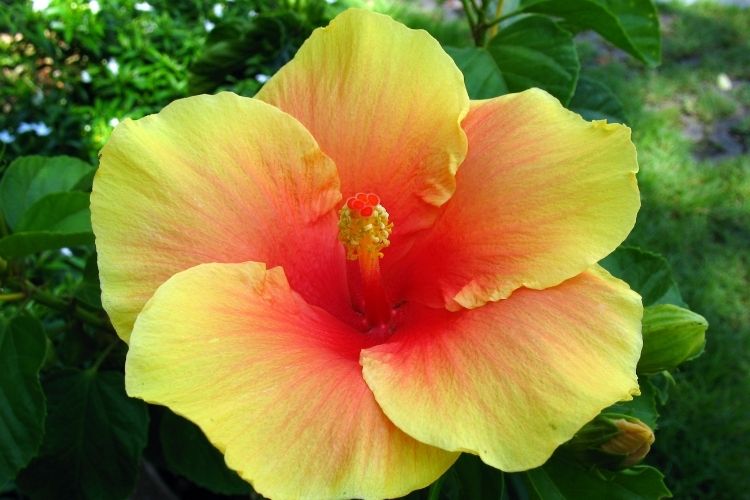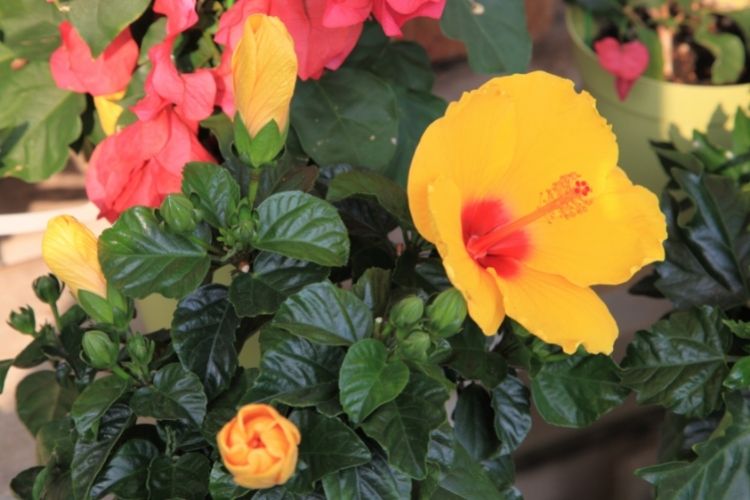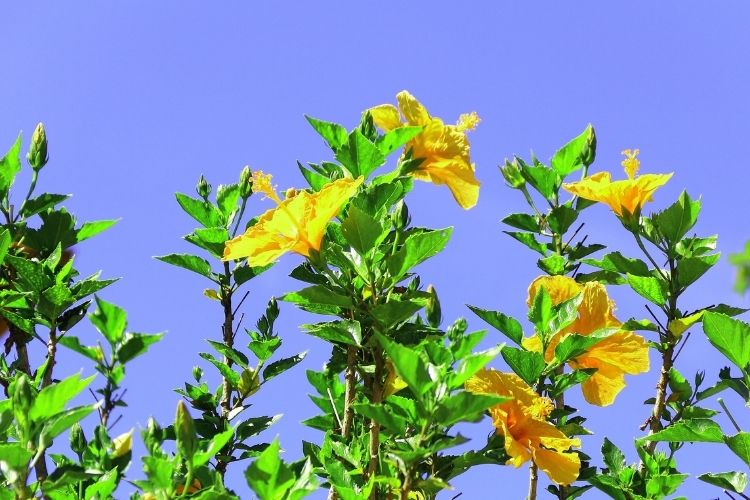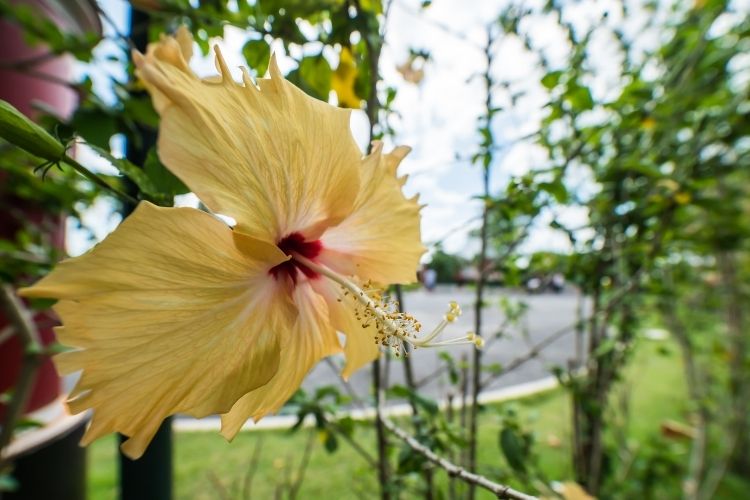- Icebox Watermelon Growing Guide: How To Grow It In Your Garden - August 21, 2021
- Duke Blueberry Growing Guide: How To Start Your Blueberry Garden? - August 21, 2021
- Pink Hibiscus Growing Guide: How To Grow One Easily? - August 16, 2021
Want to add a little tropical flair to your backyard? If so, few plants bring the island vibes quite like a hibiscus. While the Hibiscus genus contains more than 200 distinct, shrub-like plants, most are native to tropical Asia. The Yellow Hibiscus is the exception. This sunshine-hued beauty is native to Hawaii and is recognized as the state’s official flower.
Bright, bold, and eye-catching, this plant will thrive in the right conditions. Today, we’re sharing the ultimate Yellow Hibiscus Growing Guide to help you understand how to give yours the care and attention it needs!
What Is a Yellow Hibiscus?

The technical term for this plant is Hibiscus Brackenridgei. It’s a large, woody shrub that produces richly-toned yellow flowers, complete with a dark red center. While the blooms can reach up to six inches in diameter, the plant itself can tower much higher. In certain tropical climates, you can find Yellow Hibiscuses that soar up to 16 feet tall!
Though it’s mostly considered a warm-weather annual, this plant can produce blooms all year round with certain temperatures and weather conditions. You can also plant and grow a Yellow Hibiscus indoors, and it makes a gorgeous houseplant that’s sure to be an instant conversation piece.
In Hawaii, Yellow Hibiscus plants are considered symbols of friendship and joy. They also signal new beginnings and good fortune. For this reason, they’re often given as housewarming gifts or as presents between friends.
Though their ornamental value is immense, these plants also deliver hard-working benefits to any garden! Their large flowers attract a variety of pollinating insects, including bees and butterflies. They’re also a popular hummingbird hangout!
Planting a Yellow Hibiscus: Your Step-by-Step Guide
Ready to plant your Yellow Hibiscus? You can easily grow a healthy plant indoors or outdoors. Here are the techniques to use for each approach.
Planting Outdoors
If you decide to plant your Yellow Hibiscus outdoors, follow these steps:
- Dig a hole as deep as the plant’s root ball, and two to three times as wide.
- Carefully remove the hibiscus from its container.
- Position the shrub in the potting hole.
- Backfill the hole halfway with soil dug from the same spot.
- Water the plant to settle it and remove any air pockets.
- Fill the hole up the rest of the way and pat down the soil.
- Water thoroughly until the ground is moist.
A Yellow Hibiscus is striking on its own, but you can make a beautiful hedge by placing multiples in a row. If you decide to plant more than one, then follow the instructions above. Add three to six feet of space between each plant to encourage healthy growth.
Planting In a Container
Want to keep your hibiscus nearby so you can enjoy it every day? As long as you choose a container that is appropriately sized, you can grow this plant indoors. Here are the steps to follow:
- Find a container that is as deep as the plant’s root ball, and two to three times as wide.
- Carefully remove the shrub from its original container.
- Place the shrub in the potting hole.
- Backfill the hole halfway with potting soil designed for indoor use.
- Water the plant to settle it and remove any air pockets.
- Add more potting soil up to the top of the container.
- Water the plant thoroughly.
Note that when left wild, a hibiscus can easily grow into a towering tree! It’s usually warmer inside your home than outside of it, and that climate is most similar to the tropical conditions that this plant needs to thrive. Don’t be surprised if your plant becomes a little unwieldy as time goes by! If it outgrows its current container, you may need to re-pot it if you notice that it’s exhibiting signs of stress.
Yellow Hibiscus Growing Guide: Key Requirements

Once your Yellow Hibiscus is happily settled into its new home, how can you keep it looking its best? The key is to know exactly what it needs at all times. Let’s take a look at a few of the most important considerations to keep in mind.
Sunlight Requirements
As you might imagine, this tropical beauty is a sun-loving plant! If you’re planting it outdoors, then look for a spot that gets full sun, or at least six to eight hours of sunlight daily. These make beautiful additions to your pool or patio area!
If you plant yours indoors in a container, then place it in a sunny spot where it’s sure to get plenty of sunlight. While it might grow moderately under artificial light, that’s no substitute for the real thing. Most likely, you’ll notice that your plant will survive just fine, but won’t deliver those eyebrow-raising blooms that you’d find outdoors. If it does produce blooms, then they’ll grow slowly or never flower at all.
With an adequate amount of sunlight, your Yellow Hibiscus should produce a large quantity of fully developed flowers.
Temperature Requirements
Although there are some varieties that are hardier than others, most hibiscus plants are not very cold-tolerant. In fact, they grow best in USDA Plant Hardiness Zones 11 through 13. You’ll need to keep this in mind whether you plant yours outdoors or in an indoor container.
Ideally, they prefer temperatures that don’t drop too much below 40 degrees Fahrenheit or even 50 degrees Fahrenheit. As soon as it gets chillier than that, you may start to notice the plant’s leaves turn from green to yellow. They may also start to fall off the plant.
As soon as the temperatures begin to rise again, this activity should reverse and your plant will start growing again.
If you live in an area that sees cold winters (which applies to most states in the U.S.), then it’s best to plant your Yellow Hibiscus in a container, even if you plan to keep it outdoors. This way, you can bring it inside when the seasons change and it gets too cold for it to live.
Another aspect to keep in mind? If you live in a windy climate, then your temperatures may naturally be colder at certain parts of the day.
Not only could this leave your plant vulnerable to leaf loss, but the wind itself could tear the delicate blooms. You can still grow your Yellow Hibiscus outdoors, but choose a covered spot where it will be protected, such as beneath a back porch awning.
Soil Requirements
Like all other hibiscus plants, the Yellow Hibiscus prefers well-drained soil. Its roots need plenty of oxygen to spread out and grow, and they can’t get it if their roots are water-logged and compacted. If you notice that the leaves on your plant have started to wilt, then the soil might be too moist.
You might also find that it’s too acidic, or not acidic enough. Yellow Hibiscus plants grow best in soil pH that measures between 6.5 and 6.8. If you conduct a soil test and find that yours is outside of these parameters, then you can amend it.
Adding lime to your soil will increase the pH while adding sulfur will lower it. Once you make your amendments, wait two weeks and retest your soil. In most cases, unamended soil isn’t ideal for planting a hibiscus. Whether you’re growing yours in a garden or inside of your home, it’s best to use a well-draining potting mix. To make it, simply combine the following:
- Two parts standard potting soil
- Two parts peat moss
- One part perlite
This soil is usually rich enough that it will suffice on its own without fertilization. You can also enrich the soil by adding homemade or store-bought compost, as well as earthworm casings available at your local home and garden store.
If you want to increase the soil fertility even more, you can also use specially formulated plant food in your planting area, following the manufacturer’s instructions.
Fertilizer Requirements
As mentioned, most Yellow Hibiscus plants grow well with amended soil and do not require much additional fertilization. However, there are certain solutions that you can try. Stick to those designed specifically for flowering plants, and feed it every two weeks once the plant is established and showing new growth.
Most of these solutions will follow a formula type of 0-10-10. They are designed to promote ample blooming and excellent root growth.
Pruning Requirements
If you live in a tropical climate and plant your Yellow Hibiscus outdoors, then it could very likely grow beyond your expectations. However, pruning is still important, even if yours grows only moderately.
Although they are beautiful, hibiscus blooms are short-lived and only last a few days. Once the bloom closes back up, it falls to the ground. To keep the area around your plant neat and clean, you can snip off old blooms before this happens.
If you over-winter your hibiscus or bring it indoors when temperatures drop, then you’ll need to prune it back before warm weather hits again. In late winter or early spring, cut the plant back by about one-third. If you notice that any branches are crossing one another or drooping, then you can cut those off, too.
Water Requirements
In Hawaii, Yellow Hibiscus plants do not see a large amount of rainfall. As such, they’re acclimated to dry conditions, although native plants also have a deep root system that allows them to obtain the nutrients they need.
While the top portion of the roots remains relatively dry with ample oxygen access, the deeper roots absorb water from the ground and deliver it to the plant.
How can you recreate the same type of environment at your home? The secret is to practice caution while watering. To avoid giving your plant too much water, wait until the top two inches of soil dry out a little. Then, add just enough water to moisten the soil again.
The first week after planting, you can water your hibiscus daily. By the second week, you can taper it off to just once every two days. By the third week, you can water your plant about two times per week. If you notice that there hasn’t been much rainfall or the soil feels particularly dry, then increase this frequency.
Propagating a Yellow Hibiscus

If your climate and conditions are favorable, you may find that you have more Yellow Hibiscus than you need! If this is the case, you can use stem cuttings to share the joy of this plant with others. Most hibiscus varieties and other woody shrubs are easy to propagate this way.
First, find the right cutting. Look for a hibiscus stem that looks sturdy, with a few leaves. You need one that will be able to easily take root and grow into a new plant. The best ones to snip are those that are between five and 10 inches long, with a few leaves on the top.
If yours has a few leaves on the bottom, then go ahead and remove them. To avoid damaging the branch, use a sharp knife and cut it at a 45-degree angle.
Once you have your cutting, then you can dip the cut ends of the branch in rooting powder. While this hormone powder can help the branch take root more quickly and successfully, note that it is not required to create a new plant. Farmers and growers have been propagating plants for centuries just fine without it!
Finally, place the cutting in an environment that will encourage its growth. The most common mediums are water or peat moss. If you decide to use water, then you’ll only need to fill a cup about one inch of the way up. This is an ideal choice, as the transparency of the liquid allows you to see the new roots as they form! If you use peat moss, then create a quick solution of three parts sand to one part peat moss and add your cutting to it.
One caveat? If you use peat moss, your stem might not get the water that it needs to thrive. To remedy this, you can create what’s known as a humidity dome. Use the top and bottom of a plastic container for a DIY approach. Here’s a quick guide to help you get started!
Once your cutting has taken root, then you’re free to go ahead and plant it in your final growing pot. However, it helps to use a smaller pot first. This way, the plant can establish itself and start growing in an appropriately-sized container.
Once it outgrows that pot, then you can make the final transfer. Place the baby plant in partial shade to slowly acclimate it to full, direct sunlight.
Yellow Hibiscus: Common Pests and Diseases

For all their vibrancy, you would expect Yellow Hibiscuses to be true targets for some of the most harmful and invasive pests and plant diseases. Unfortunately, this is the case. Some of the most common creepy-crawlies that love to take up residence on this plant include:
- Spider mites
- Whiteflies
- Aphids
- Thrips
Left untreated, these pests can wreak havoc on a hibiscus plant. Some of the earliest and most important signs to look out for include:
- Plants that drop their flowers prematurely
- A sticky substance on the plant and nearby surfaces
- Plants that fail to bloom
- Plants that fail to thrive
- Holes in plant leaves and petals
While it can be disheartening to notice a pest on your plant, the good news is that most of these infestations are easy to treat. In many cases, you can remove them by simply spraying your hibiscus with a steady, firm stream of water.
For more persistent clingers, you can apply a product that works as both an insecticide and fungicide, such as Sevin Sulfur Dust. This solution gets to work quickly and will not harm your plant. Disease-wise, the most common issues that you’ll find are gray mold and powdery mildew. If these affect your Yellow Hibiscus, then you’ll begin to notice splotches on the leaves that appear white, gray, or even yellow.
You may also find that the plant produces buds that quickly mold and fall off without blooming. Again, a good shake of Sevin Dust should help solve the issue.
Where to Buy a Yellow Hibiscus

Ready to add a Yellow Hibiscus to your home? You don’t have to travel all the way to Hawaii to snag one, although we wouldn’t blame you for using that as an excuse to jet-set! Here are a few online retailers that will ship the plant right to your doorstep:
In addition, you can usually order Yellow Hibiscus plants at your local nursery. They’re also available at most home and garden stores, as well as Amazon!
FAQs
Answer: Yes! Under the right conditions, this is a perennial plant that will reward your diligence with bright yellow blooms that last from mid-spring to mid-fall every year. However, you’ll need to live in a tropical climate for this to happen or keep your hibiscus indoors and exposed to plenty of sunlight.
If you decide to over-winter your plant, you’ll need to bring it indoors and away from even the slightest threat of frost. Keep it in a location that gets plenty of sun, such as a room with large windows.
If you want a hardier hibiscus that will survive through cold temperatures, then consider a different variety that isn’t tropical. Those deciduous shrubs will feature dull, medium-green leaves with slightly smaller blooms in hues of red, white, or pink. Rose of Sharon or Rose Mallow are excellent alternatives.
Answer: Your plant looked healthy just days ago. Why is it suddenly dropping its leaves and looking sickly? While there could be many different factors at work, the most common issues center on water and soil requirements.
With too much water or not enough water, your hibiscus could start showing signs of distress. Check the soil with your fingertip to gauge how often you need to moisten it.
If that doesn’t appear to be the problem, then consider your soil. If you haven’t amended it yet, then it might be time to add the types of fertilizer described above.
Your plant might also become stressed out if you’ve recently moved it into a new environment. For instance, it may look droopy once you bring it indoors to overwinter, or as soon as you take it outside when it’s warm again. Give it a few days to re-acclimate and make sure it has the nutrients it needs.
Of course, pests could also affect your plant, so visually inspect it and treat it if you notice that’s the case.
Answer: You followed all the steps and did everything right. Your Yellow Hibiscus looks healthy, but there’s one thing wrong. It still isn’t delivering those knockout blooms you expected! What’s going on?
Often, this happens when your plant lacks one key nutrient: phosphorous. This soil ingredient is key to encouraging your plant to flower and when it’s not present (or present in minuscule amounts), then you’ll notice the difference in your plant.
You can purchase certain materials at your local plant store to increase these quantities. Bone meal, compost, and rock phosphate are two of the most common choices.
If you can’t find these in the store, then simply look for phosphorous-rich fertilizer. As it’s difficult for most plants to fully absorb phosphorous, you don’t have to worry about adding too much of this nutrient to your soil.
Answer: Ready for an investment that delivers an impressive return? Some of the older, garden-variety Yellow Hibiscus plants can live for up to 50 years or more!
If you’re in a tropical climate where temperatures stay consistently warm year-round, then you can plant yours outdoors and enjoy it for decades to come.
If you have a newer, hybrid-variety Yellow Hibiscus, then it can still live for around five to 10 years with proper care. To keep it thriving for longer, be sure to give it the right amounts of sunlight and water. It’s also important to closely monitor its environmental temperature and soil conditions.
Answer: Love the look of your hibiscus but want to encourage wider and bushier growth? You can easily shape it by carefully pruning it and strategically pinching back new growth. By following this practice, you may find that yours even become dense enough to be used as privacy hedges!
For best results, prune your plant back when the new, tender growth that forms won’t have to interact with the threat of cold or near-freezing temperatures. A tropical hibiscus variety like the Yellow Hibiscus can only tolerate a very short amount of cold before it begins to wilt.
Bring the Tropics Home With a Yellow Hibiscus
A Yellow Hibiscus is your one-way ticket to paradise, accessible any time you head outdoors! This hardy, full-blooming plant can deliver years of joy as long as you properly maintain it. In this Yellow Hibiscus Growing Guide, you have all of the information you need to keep your plant healthy and happy.
From sun and soil to temperature and water, there are many different factors that go into getting this particular plant just right. The key is to keep it warm and well-drained, which usually means moving it indoors once summer fades into fall. Looking for more gardening advice you can trust? Interested in learning about other plant varieties that can beautify your landscape? We’ve got it all, so keep reading our informative guides!

